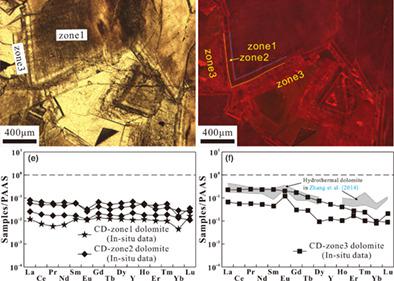当前位置:
X-MOL 学术
›
Geolog. J.
›
论文详情
Our official English website, www.x-mol.net, welcomes your
feedback! (Note: you will need to create a separate account there.)
Tracing fault-related fluids using in situ trace elements: A case study in Upper Cambrian dolostone in Gucheng area, Tarim Basin, NW China
Geological Journal ( IF 1.4 ) Pub Date : 2021-02-16 , DOI: 10.1002/gj.4105 Ziye Lu 1 , Yingtao Li 2 , Shaonan Zhang 1 , Ning Ye 1 , Bei Zhu 1 , Chaojin Lu 3 , Xiaoqi Ding 4 , Baiwen Huang 1
Geological Journal ( IF 1.4 ) Pub Date : 2021-02-16 , DOI: 10.1002/gj.4105 Ziye Lu 1 , Yingtao Li 2 , Shaonan Zhang 1 , Ning Ye 1 , Bei Zhu 1 , Chaojin Lu 3 , Xiaoqi Ding 4 , Baiwen Huang 1
Affiliation

|
The Gucheng area, located in the east of the Tarim Basin, is one of the important gas exploration targets, and the Upper Cambrian dolostone is the main pay layer. The dolostone is considered to be altered by hydrothermal fluids, but the hydrothermal altering degrees are still unclear. In this study we report the petrography and in situ trace elemental data, and try to discuss the hydrothermal fluids and their impact on the Upper Cambrian dolostones. Based on the petrography and CL properties, five types of dolomites are identified. MD1 and MD2 are the matrix dolomites. The crystal size of MD1 range from approximately 30 to 100 μm, while the MD2 is larger than 200 μm. Cement dolomite (CD) occurring only in vugs and fractures is subdivided into three types depending on the CL properties. CD-zone1 is the core of CD with dull CL colours. CD-zone2 comprises a bright red CL colour zone and a dull CL colour zone, and CD-zone3 is the rim of CD dolomite with bright red CL colours. MD2 and CD-zone1 show light rare earth elements (LREE) depletion, middle rare earth elements (MREE) enrichment and negative Eu anomalies. The REEY patterns of CD-zone3 dolomite are marked by LREE enrichment and positive Eu anomalies. CD-zone2 is the transitional mineral phase that shows slightly LREE depletion and negative Eu anomalies. The REEY patterns of CD-zone1 suggest that CD-zone1 is likely formed by local redistribution of older dolomites in a closed system. The REEY patterns of CD-zone3 may indicate a magmatic associated hydrothermal fluid. Based on the petrography and in situ trace elemental data, the Permian magmatic fluid, which is recorded in CD-zone2 and CD-zone3 dolomites, may be only limited within fractures, while unlikely significantly altered the matrix dolomite in the Upper Cambrian.
中文翻译:

利用原位微量元素示踪断层相关流体——以塔里木盆地古城地区上寒武统白云岩为例
塔里木盆地东部的古城地区是重要的天然气勘探目标之一,上寒武统白云岩是主要的产层。白云岩被认为受到热液蚀变,但热液蚀变程度尚不清楚。在这项研究中,我们报告了岩石学和原位微量元素数据,并尝试讨论热液流体及其对上寒武统白云岩的影响。根据岩相学和CL性质,确定了五种类型的白云岩。MD1 和 MD2 为基质白云岩。MD1 的晶体尺寸范围从大约 30 到 100 μm,而 MD2 大于 200 μm。仅在孔洞和裂缝中出现的水泥白云岩 (CD) 根据 CL 特性细分为三种类型。CD-zone1是CD的核心,CL颜色暗淡。CD-zone2包括亮红色CL色区和暗CL色区,CD-zone3为CD白云岩边缘,CL色为亮红色。MD2和CD-zone1显示出轻稀土元素(LREE)耗尽、中稀土元素(MREE)富集和Eu负异常。CD-zone3白云岩的REEY模式以LREE富集和Eu正异常为标志。CD-zone2 是过渡矿物相,显示出轻微的 LREE 消耗和负 Eu 异常。CD-zone1 的 REEY 模式表明 CD-zone1 可能是由老白云岩在封闭系统中的局部重新分布形成的。CD-zone3 的REEY 模式可能表明岩浆伴生热液。根据岩石学和原位微量元素数据,CD-zone2和CD-zone3白云岩中记录的二叠纪岩浆流体,
更新日期:2021-02-16
中文翻译:

利用原位微量元素示踪断层相关流体——以塔里木盆地古城地区上寒武统白云岩为例
塔里木盆地东部的古城地区是重要的天然气勘探目标之一,上寒武统白云岩是主要的产层。白云岩被认为受到热液蚀变,但热液蚀变程度尚不清楚。在这项研究中,我们报告了岩石学和原位微量元素数据,并尝试讨论热液流体及其对上寒武统白云岩的影响。根据岩相学和CL性质,确定了五种类型的白云岩。MD1 和 MD2 为基质白云岩。MD1 的晶体尺寸范围从大约 30 到 100 μm,而 MD2 大于 200 μm。仅在孔洞和裂缝中出现的水泥白云岩 (CD) 根据 CL 特性细分为三种类型。CD-zone1是CD的核心,CL颜色暗淡。CD-zone2包括亮红色CL色区和暗CL色区,CD-zone3为CD白云岩边缘,CL色为亮红色。MD2和CD-zone1显示出轻稀土元素(LREE)耗尽、中稀土元素(MREE)富集和Eu负异常。CD-zone3白云岩的REEY模式以LREE富集和Eu正异常为标志。CD-zone2 是过渡矿物相,显示出轻微的 LREE 消耗和负 Eu 异常。CD-zone1 的 REEY 模式表明 CD-zone1 可能是由老白云岩在封闭系统中的局部重新分布形成的。CD-zone3 的REEY 模式可能表明岩浆伴生热液。根据岩石学和原位微量元素数据,CD-zone2和CD-zone3白云岩中记录的二叠纪岩浆流体,











































 京公网安备 11010802027423号
京公网安备 11010802027423号